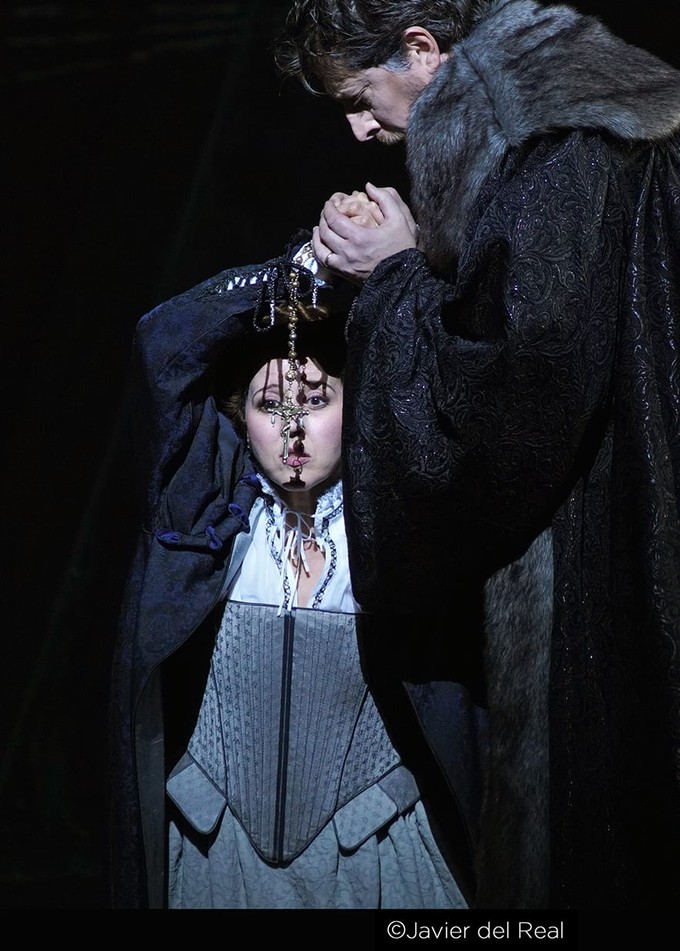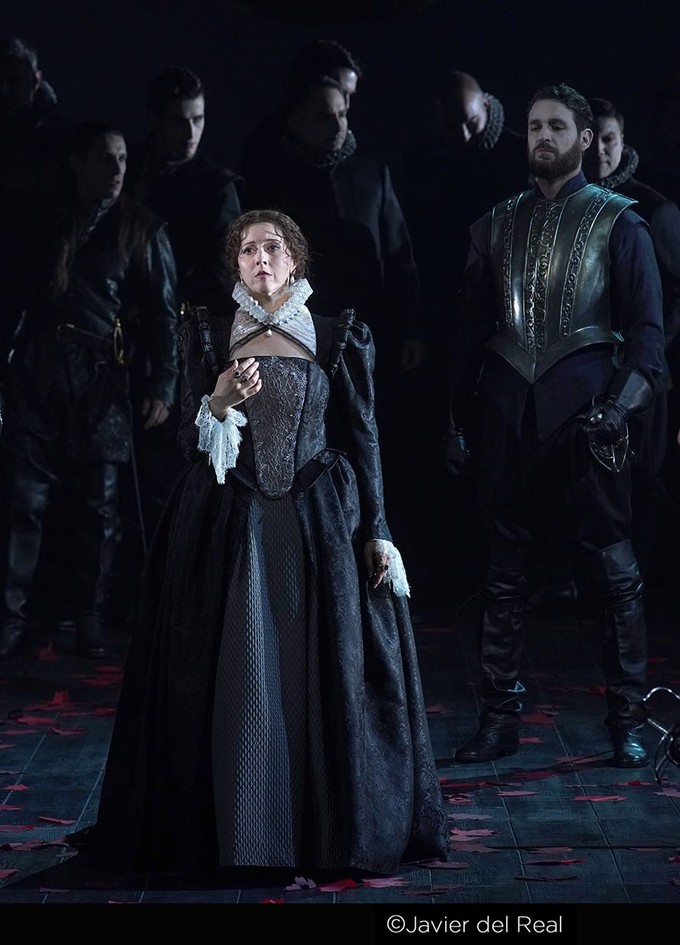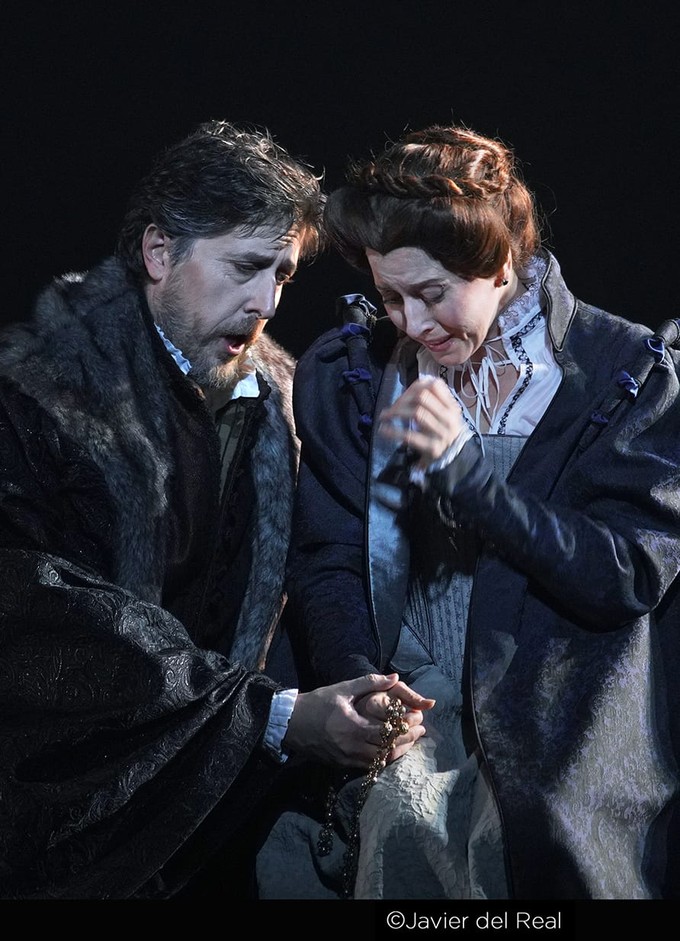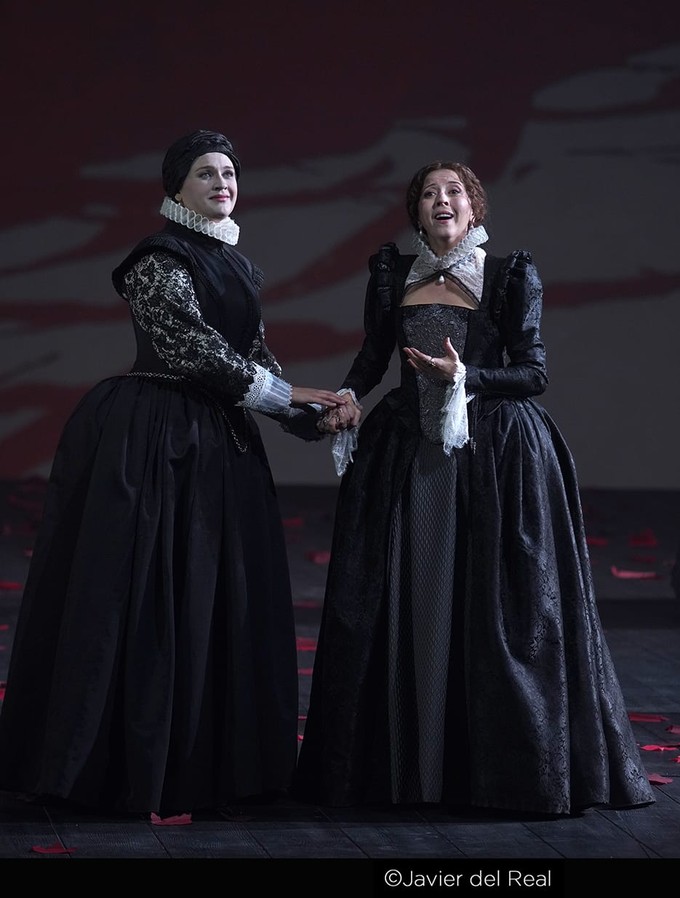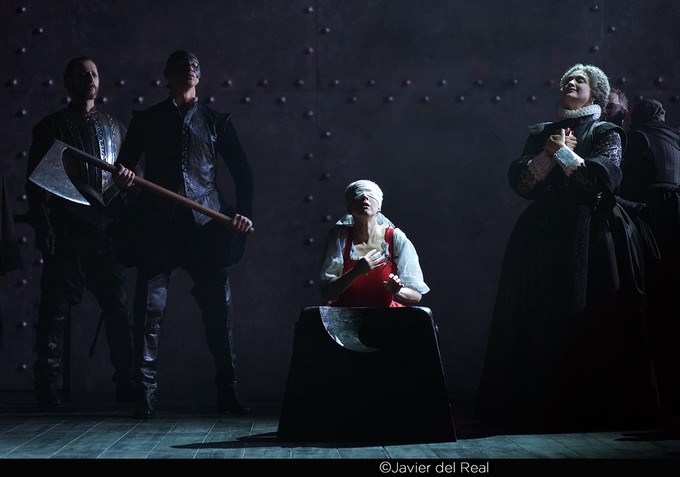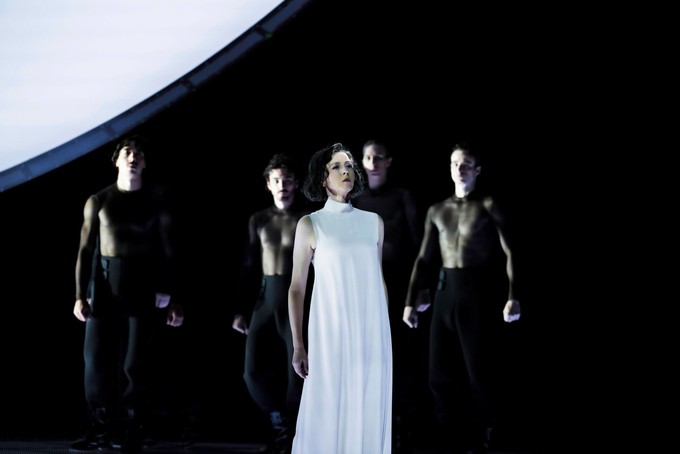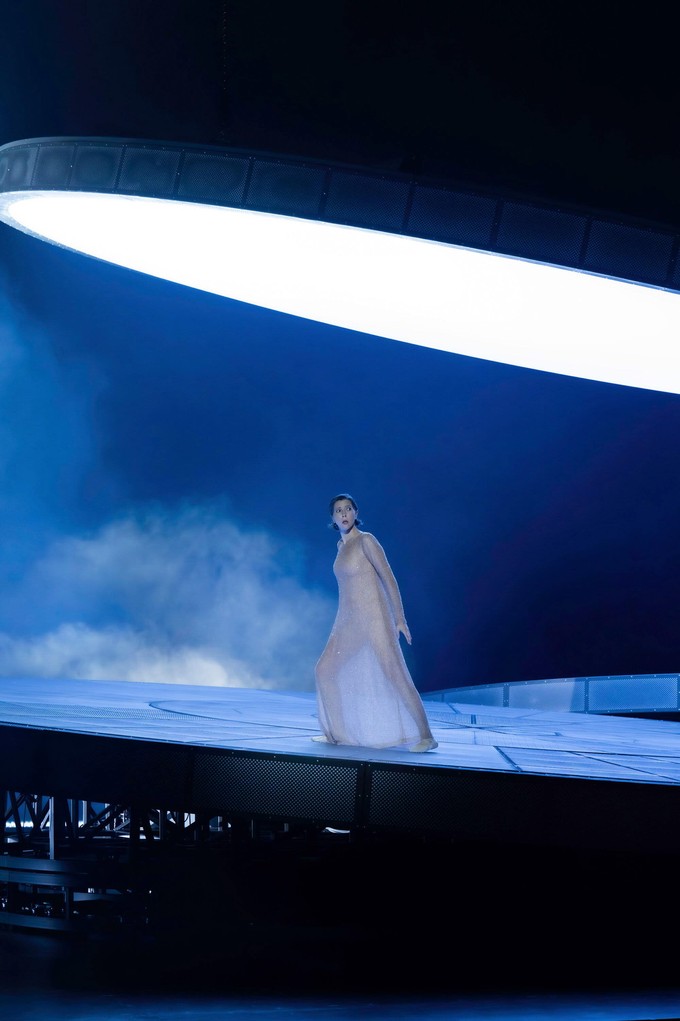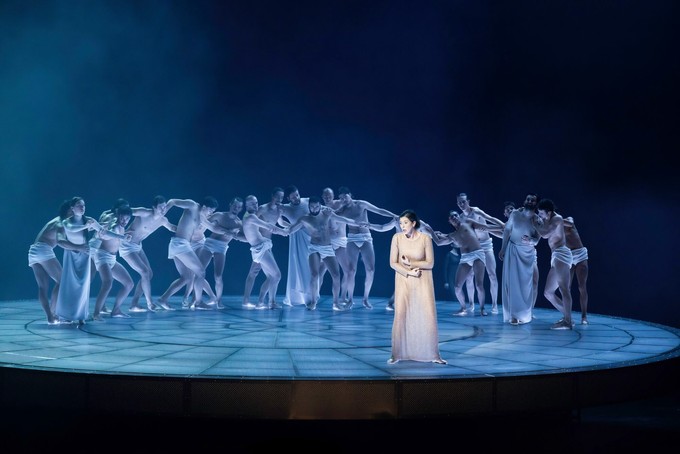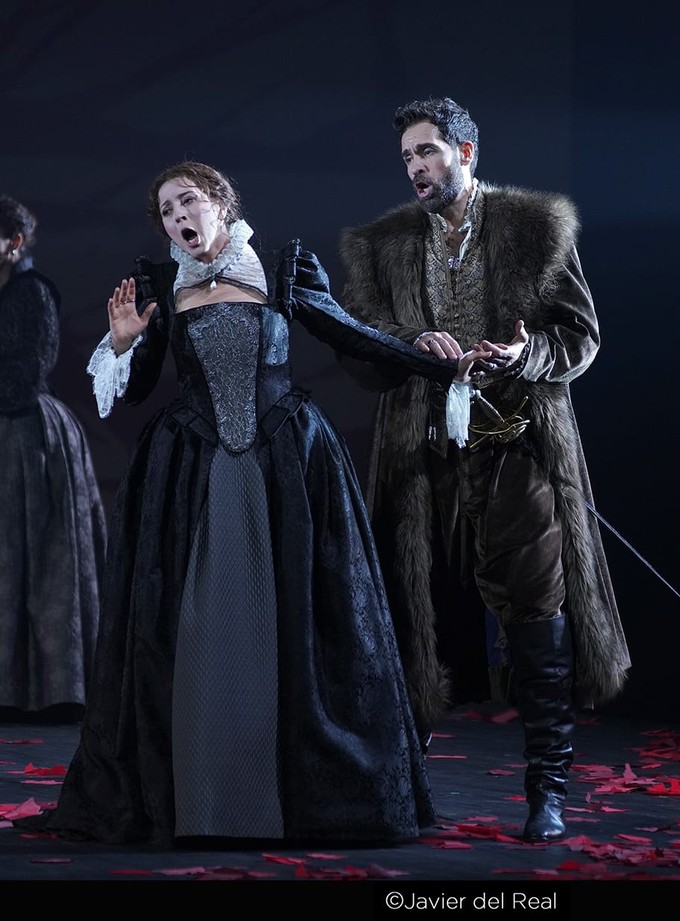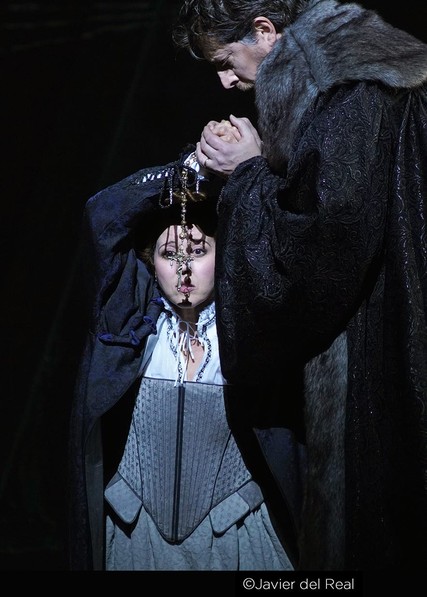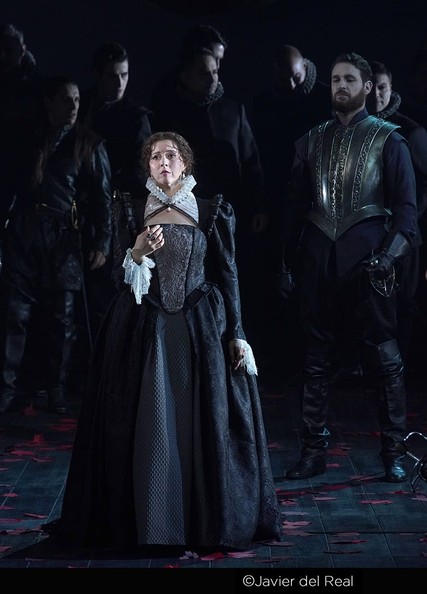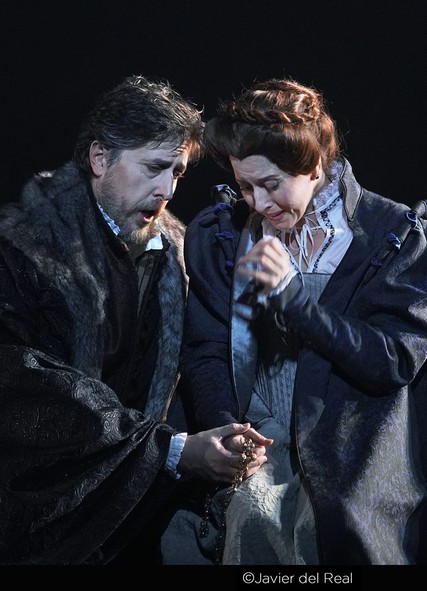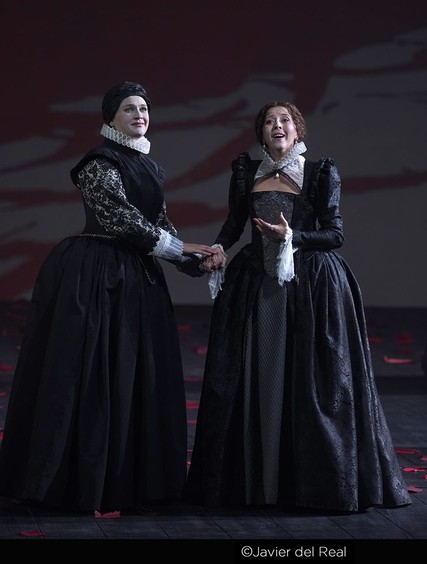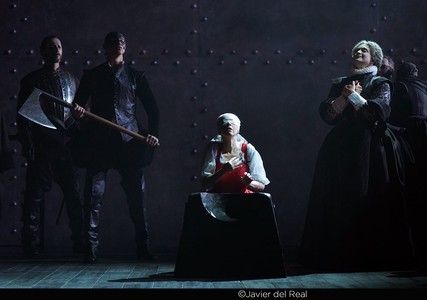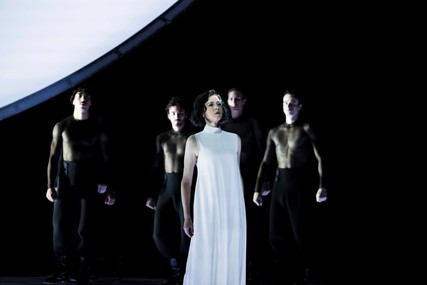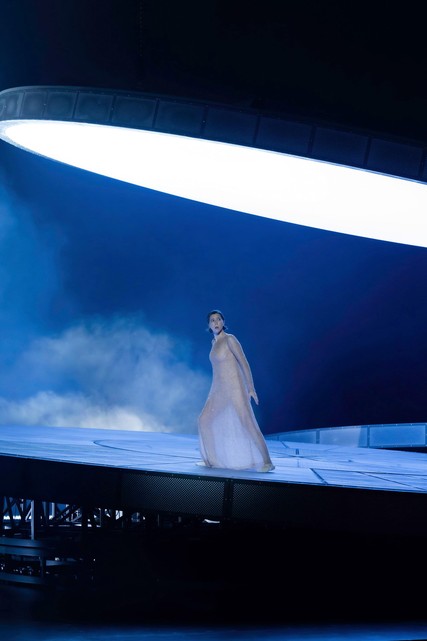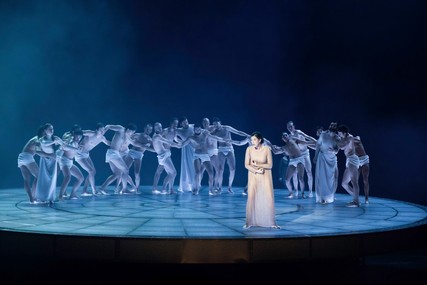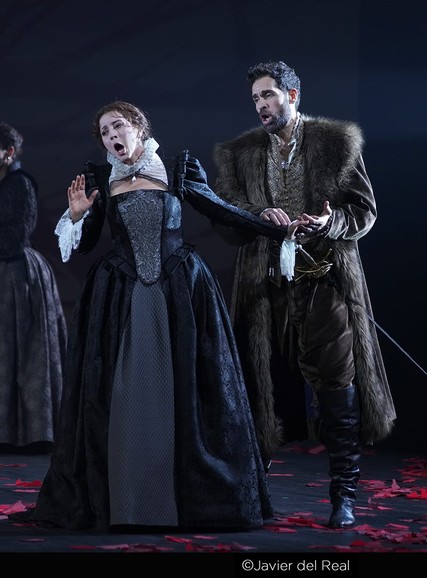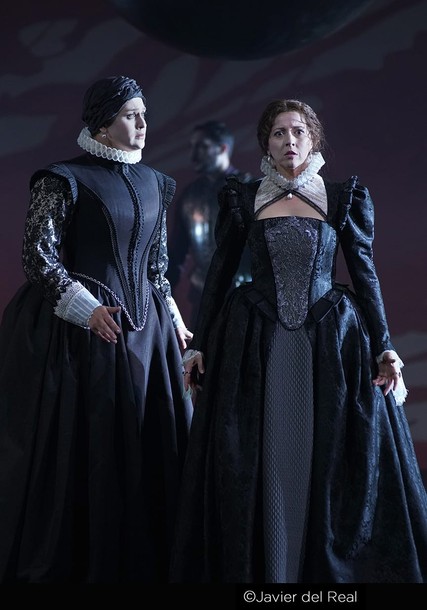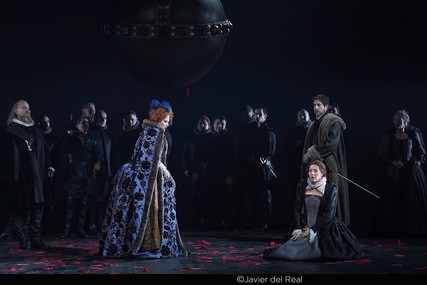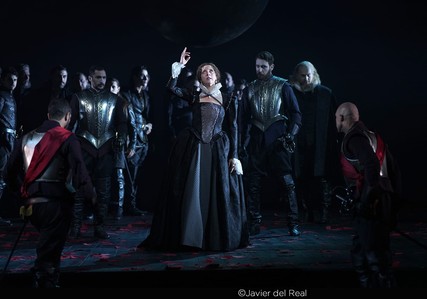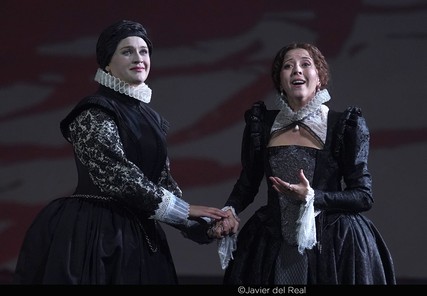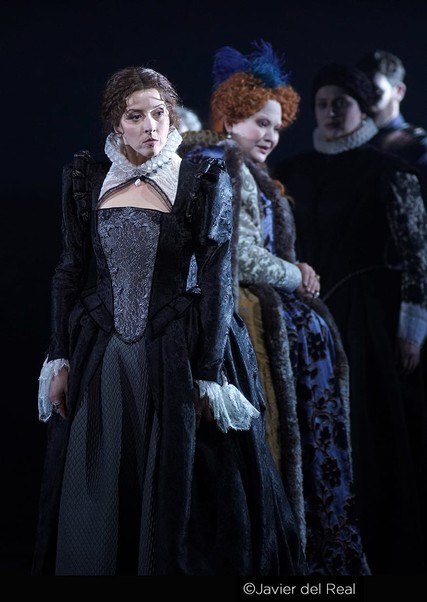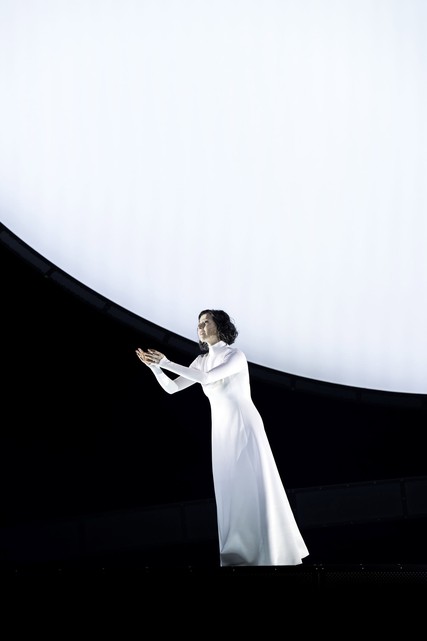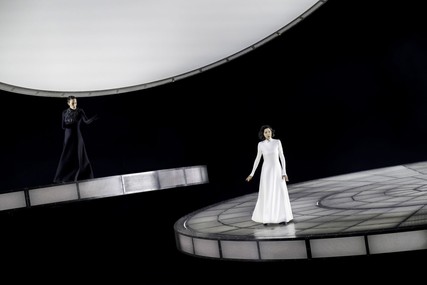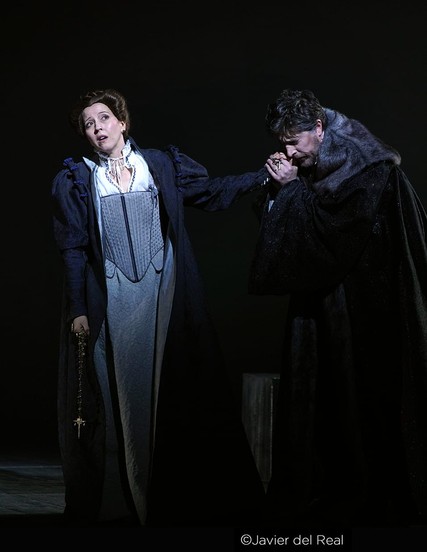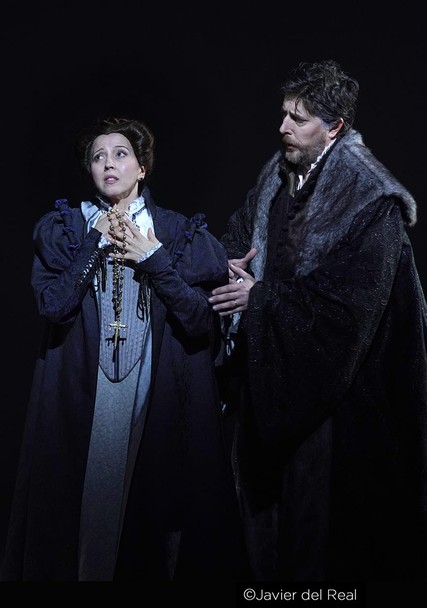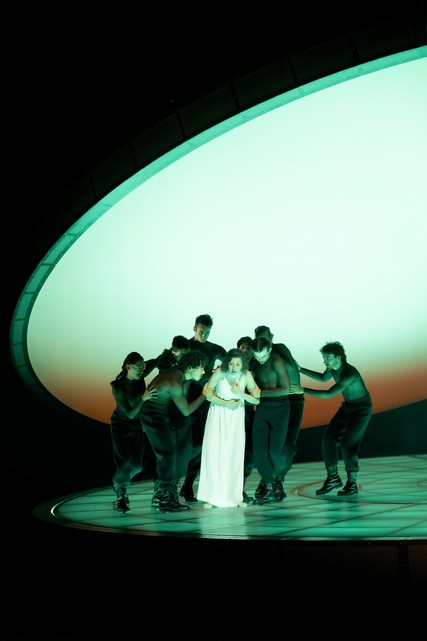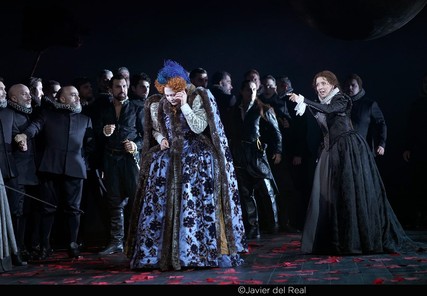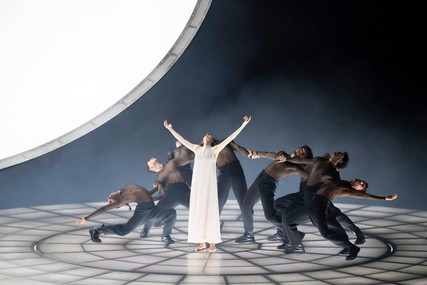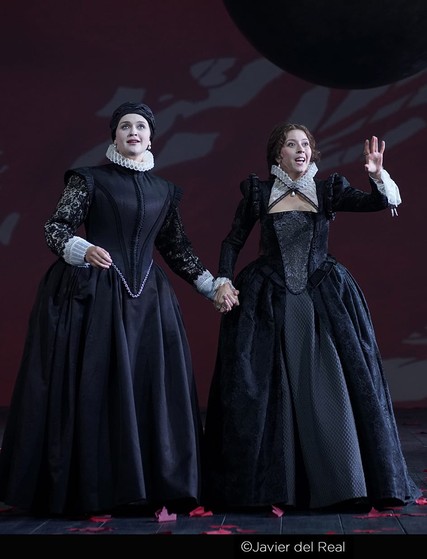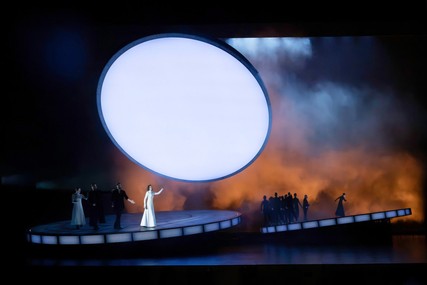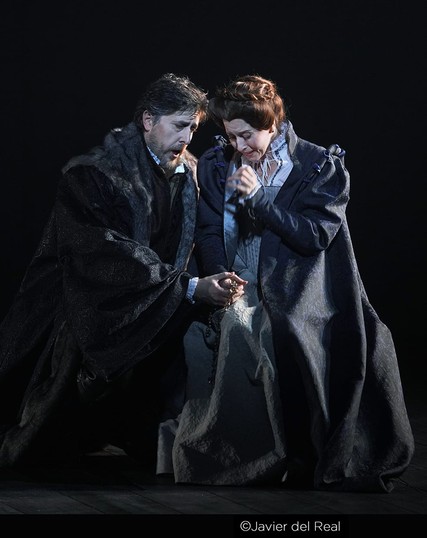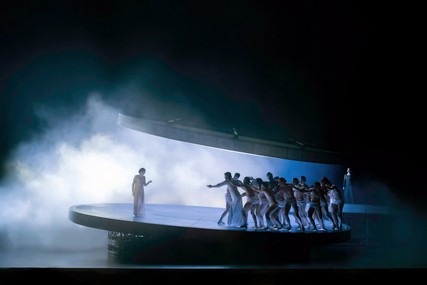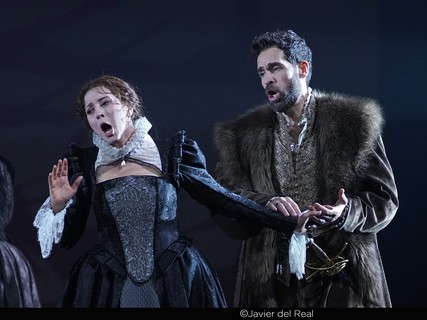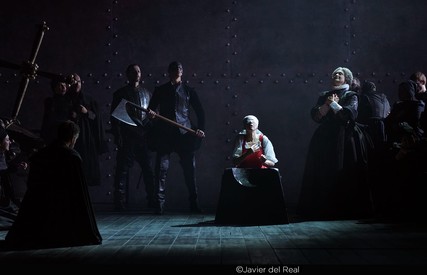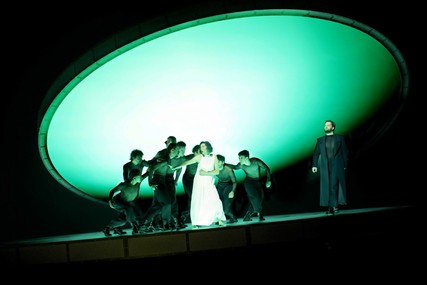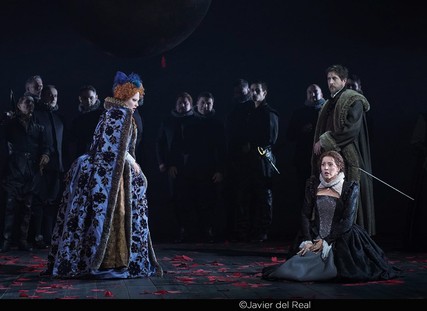Maria Stuarda in Maria Stuarda
Lisette Oropesa's portrayal of Maria Stuarda has been met with widespread acclaim across various renowned publications, highlighting her mastery of the bel canto style and her ability to bring depth and nuance to the character. Critics consistently praise her for her vocal flexibility, precise phrasing, and her ability to project with both power and delicacy. Her performance is frequently described as enchanting and captivating, with Oropesa displaying a unique blend of technical proficiency and emotional expressiveness. This combination allows her to embody the character of Maria with both the regality and vulnerability that the role demands.
A recurring theme in the reviews is Oropesa's ability to maintain a seamless legato, particularly in the high register, which is described as both unfilled and sustained with remarkable control. Her interpretation is noted for its emotional impact, often moving audiences with her entrance cavatina and prayer scenes. Critics also highlight her exceptional stage presence and the strong partnership she forms with directors to fully realize their vision, suggesting that Oropesa's performances are not only vocally compelling but also theatrically profound.
In summary, Lisette Oropesa's Maria Stuarda is recognized for its combination of technical brilliance and emotive power, positioning her as a standout interpreter of the role. Her performances are celebrated for their beauty, clarity, and the seamless integration of vocal and dramatic elements, making her portrayal an anthology-worthy contribution to the opera world.
Lisette has been reviewed 61 times in this role.
Role Information
- Composer: Gaetano Donizetti
- Opera: Maria Stuarda
- Performances: 13
- Reviews: 61
- Venues: 2
- Organizations: 2
- Years: 2024 - 2025
Lisette Oropesa was able to enjoy a true storm of applause after the premiere. She knows how to serve the coloratura in such a way that it never feels like external decoration. It is fabulous how she effortlessly and unstrainedly hits the most exposed notes, as well as how she brings a maximum of softness to the cantilena - there,…
Lisette Oropesa was able to enjoy a true storm of applause after the premiere. She knows how to serve the coloratura in such a way that it never feels like external decoration. It is fabulous how she effortlessly and unstrainedly hits the most exposed notes, as well as how she brings a maximum of softness to the cantilena - there, too, these two queens are actually twins.
— DrehPunktKultur, August 2025
Lisette Oropesa was fabulous, both technically and interpretively. Maria is a role with a central tessitura, and at first, I thought Oropesa's voice, from what I had seen of her until now, leaned more towards the high register. Well, I got the impression that her voice is evolving in different directions, and the artist's work is no stranger to this.…
Lisette Oropesa was fabulous, both technically and interpretively. Maria is a role with a central tessitura, and at first, I thought Oropesa's voice, from what I had seen of her until now, leaned more towards the high register. Well, I got the impression that her voice is evolving in different directions, and the artist's work is no stranger to this. The transition to the lower register is very well-developed to give sonority to this range of the voice while maintaining uniformity in the instrument.
— Scherzo Magazine, December 2024
Oropesa has preserved the basic lyricism of her capable coloratura soprano. She develops the demanding role from a shimmering, sorrow-veiled basic sound, which she also incorporates into virtuosic and elegant phrases.
Oropesa has preserved the basic lyricism of her capable coloratura soprano. She develops the demanding role from a shimmering, sorrow-veiled basic sound, which she also incorporates into virtuosic and elegant phrases.
— Die Presse, August 2025
Maria Stuarda is another step in Lisette Oropesa's evolution towards more lyrical and less light roles. The warmth of the sound, the meticulousness of the phrasing, and the art of chiaroscuro made her a poignant queen.
Maria Stuarda is another step in Lisette Oropesa's evolution towards more lyrical and less light roles. The warmth of the sound, the meticulousness of the phrasing, and the art of chiaroscuro made her a poignant queen.
— Opera Actual, August 2025
The two central performances are terrific in their different ways. Lisette Oropesa, dressed in virginal white apart from a shimmering gold gown for her execution, is a bel canto queen, right at home in Donizetti’s demanding vocal writing. Her technique – perfect coloratura, seamless legato – is revered across the operatic world, but the expressive way she shades the music…
The two central performances are terrific in their different ways. Lisette Oropesa, dressed in virginal white apart from a shimmering gold gown for her execution, is a bel canto queen, right at home in Donizetti’s demanding vocal writing. Her technique – perfect coloratura, seamless legato – is revered across the operatic world, but the expressive way she shades the music goes beyond technique into presenting a believable character in her sympathetic portrait.
— Gramophone, September 2025
With meticulous actors' direction, soprano Lisette Oropesa made her debut in the demanding role of Stuarda, her first dramatic Donizetti. And while it wasn't the bel canto apotheosis, she gave credibility to the queen who humiliates and angers herself, the naive one who insults the monarch only to later, walk toward the ordeal, the redemption and the resignation.
With meticulous actors' direction, soprano Lisette Oropesa made her debut in the demanding role of Stuarda, her first dramatic Donizetti. And while it wasn't the bel canto apotheosis, she gave credibility to the queen who humiliates and angers herself, the naive one who insults the monarch only to later, walk toward the ordeal, the redemption and the resignation.
— La Vanguardia, December 2024
But of course, as is customary in this opera genre, the two leading ladies are the fixed stars of this extraordinary "Stuarda." Lisette Oropesa, currently leading in the youthful-dramatic coloratura field, sings as Maria with a soft yet determined tone, risking an open, opaque high range, caressing yet magnificent in the middle register. With her, one can hear at every…
But of course, as is customary in this opera genre, the two leading ladies are the fixed stars of this extraordinary "Stuarda." Lisette Oropesa, currently leading in the youthful-dramatic coloratura field, sings as Maria with a soft yet determined tone, risking an open, opaque high range, caressing yet magnificent in the middle register. With her, one can hear at every moment the effortlessly elaborated bel canto skills.
— Welt.de, August 2025
In this second night performance, Oropesa sang wonderfully. That’s no surprise for someone whose technique is regularly outstanding – sparkling coloratura, even trills, seamless legato – but it’s the way she used these tools that impressed: a warm vibrato, shading of dynamics and delivery of text combined to create a sympathetic portrait of a believably real woman.
In this second night performance, Oropesa sang wonderfully. That’s no surprise for someone whose technique is regularly outstanding – sparkling coloratura, even trills, seamless legato – but it’s the way she used these tools that impressed: a warm vibrato, shading of dynamics and delivery of text combined to create a sympathetic portrait of a believably real woman.
— Gramophone, August 2025
Lisette Oropesa in the title role is not one to parade her art as a triumph. You won’t find any glittering fireworks of ornamentation with her; for that reason, comparisons with the great bel canto predecessors don’t really hold. This very lyrical voice is veiled in melancholy and sorrow. Her singing grows out of a luxuriant middle register; everything is…
Lisette Oropesa in the title role is not one to parade her art as a triumph. You won’t find any glittering fireworks of ornamentation with her; for that reason, comparisons with the great bel canto predecessors don’t really hold. This very lyrical voice is veiled in melancholy and sorrow. Her singing grows out of a luxuriant middle register; everything is phrased tastefully and with unfailing stylistic assurance. Only in the stratospheric reaches (opening-night stress?) does it turn a bit flat. Oropesa, currently a leading figure in this field, doesn’t show off the part—she feels it.
— Merkur.de, August 2025
Lisette Oropesa is a top-tier bel canto singer, and in the role of the eponymous heroine, she is the protagonist of a monumental display of art in her use of vocal abilities and in her embodiment of the character, which is rendered with a flourishing variety of colors and nuances.
Lisette Oropesa is a top-tier bel canto singer, and in the role of the eponymous heroine, she is the protagonist of a monumental display of art in her use of vocal abilities and in her embodiment of the character, which is rendered with a flourishing variety of colors and nuances.
— Le Salon Musicale, August 2025
Lisette Oropesa shines brilliantly in the titular role. Her voice is sumptuously beautiful in all registers, with a rich and clear timbre, and flawless virtuosity.
Lisette Oropesa shines brilliantly in the titular role. Her voice is sumptuously beautiful in all registers, with a rich and clear timbre, and flawless virtuosity.
— Forum Opera, August 2025
Lisette Oropesa as Maria Stuarda is a stunning force. Then there is Lisette Oropesa's vocal interpretation of this not so angelic Passion Queen Maria Stuarda, which is as beautiful. This singer is a stunning force. She carries her heart on her sleeve, with her coloratura, her singing rising effortlessly to the heights during the trials of the journey, serving as…
Lisette Oropesa as Maria Stuarda is a stunning force. Then there is Lisette Oropesa's vocal interpretation of this not so angelic Passion Queen Maria Stuarda, which is as beautiful. This singer is a stunning force. She carries her heart on her sleeve, with her coloratura, her singing rising effortlessly to the heights during the trials of the journey, serving as a ray of light in this performance immersed in mechanistic darkness.
— SWR.de, August 2025
The best part of the night continued until the end of the opera. Donizetti admirably balances the sordid with the sublime, but he requires a vocal artist with the talent, expressiveness, and fortitude of Lisette Oropesa. The Cuban-born American soprano crowned an impressive psychological evolution from violent confrontation to spiritual elevation with 25 minutes of exceptional singing. Her rendition of…
The best part of the night continued until the end of the opera. Donizetti admirably balances the sordid with the sublime, but he requires a vocal artist with the talent, expressiveness, and fortitude of Lisette Oropesa. The Cuban-born American soprano crowned an impressive psychological evolution from violent confrontation to spiritual elevation with 25 minutes of exceptional singing. Her rendition of the beautiful D’un cor che muore, which was nearly ruined by a cell phone, was the most emotional number, and she crowned it with exquisite legato singing. But her majestic final, Ah! se un giorno da queste ritorte, was no less impressive, with an exquisite affrettando and the addition of a blinding, ultra-high daperforming a re performed before resting her head on the block and seeing the executioner raise the axe. Oropesa also shone in her first-act cavatina, with exquisite phrasing, and displayed outstanding virtuosity in the cabaletta, which she tastefully adorned in the repetition.
— El Pais, December 2024
Oropesa hits the mark with her entrance aria "Oh nube! che lieve per l'aria t'aggiri" and knows how to imbue "Di un cor che more" with emotion, within what Donizetti dubbed "the aria of torment" at the opera's end, culminating grandly in the cabaletta "Ah!, if one day these pains". Confidence in the high register - a sliding note does…
Oropesa hits the mark with her entrance aria "Oh nube! che lieve per l'aria t'aggiri" and knows how to imbue "Di un cor che more" with emotion, within what Donizetti dubbed "the aria of torment" at the opera's end, culminating grandly in the cabaletta "Ah!, if one day these pains". Confidence in the high register - a sliding note does not detract - clarity in emission, and emotional drive, singing, yes, but also acting. Returning to the beginning, in that final scene, I felt an emotion I hadn't experienced in a long time, bringing tears to my eyes. For a moment, with closed eyes, one could again hear the nuances and power of Caballé, and upon opening them, I could even see her on stage. Believe me, that is a great credit to Oropesa, who, by the way, now resides in Madrid with an apartment in La Latina.
— La Razón, December 2024
And then there is Lisette Oropesa, who contrasts the black spider with the profile of a tender white bird (one can already see the subtleties of the staging). Lisette Oropesa achieves an immense success, and it is obviously justified. Her voice has broadened, her phrasing is impeccable, her diction as always a model of clarity, she sings with the colors…
And then there is Lisette Oropesa, who contrasts the black spider with the profile of a tender white bird (one can already see the subtleties of the staging). Lisette Oropesa achieves an immense success, and it is obviously justified. Her voice has broadened, her phrasing is impeccable, her diction as always a model of clarity, she sings with the colors that one would like to hear in the orchestra pit and with her partner, with an infinite palette linked to her vocal control, mastering the filati, the passages, but also the low notes, and particularly expressive (she has sung Verdi and that is also clear). Oropesa has a way of singing that seems to display fragility but is in fact of true solidity, with the intended accents, with style: she is the only true bel canto singer on stage and knows how to be both the fragile Maria and the determined Maria because she is also a sensitive interpreter. Her voice does not have a stunning volume, but the projection, breath control, and line show an incredible technical mastery. A pure bel canto technique that allows her - and this is not a paradox - to approach Rossini as well as Verdi, Bellini as well as Meyerbeer, with the added bonus of Massenet or Gounod. A huge performance, which was anticipated and which confirms for us this well-crafted career that remains fairly linear and cautious.
— Wanderer, August 2025
Lisette Oropesa's voice is highly commendable - she is one of the most versatile sopranos in recent years, consistently coherent in her repertoire choices - in the role of the Queen of Scotland. Her interpretation confirms the quality already appreciated many times, in her firm vocal emission, her trills, the vibrato in the elegiac parts, and her pronunciation, although the…
Lisette Oropesa's voice is highly commendable - she is one of the most versatile sopranos in recent years, consistently coherent in her repertoire choices - in the role of the Queen of Scotland. Her interpretation confirms the quality already appreciated many times, in her firm vocal emission, her trills, the vibrato in the elegiac parts, and her pronunciation, although the more agitated moments are not free from some shadows (for example, less precise agility). The Madrid audience gives her a true triumph, also because she truly is an excellent interpreter of the long final scene, with the interaction with the choir (always very professional) and the voice modulation of the desperate prayer.
— GB Opera Magazine, December 2024
The roles of the two rival queens are very vocally demanding, but both the jealous and cold Elizabeth I, insecure and fearsome, in the powerful voice of Russian mezzo Aigul Akhmetishina, and the exquisite voice of Mary Stuart through soprano Lisette Oropesa, displaying all the delicacy and finesse of bel canto, were entirely up to the challenge, and the audience…
The roles of the two rival queens are very vocally demanding, but both the jealous and cold Elizabeth I, insecure and fearsome, in the powerful voice of Russian mezzo Aigul Akhmetishina, and the exquisite voice of Mary Stuart through soprano Lisette Oropesa, displaying all the delicacy and finesse of bel canto, were entirely up to the challenge, and the audience gave a thunderous applause after some astonishing arias. The role of Stuart is highly complex due to the shifts from fear, despair, anguish, or scorn. Both were formidable in their duets and convincing in their expressiveness and mastery of their voices, with Mary ending before reaching the scaffold with the splendid cabaletta. A luxurious cast.
— El Día de Soria, December 2024
And this type of stage presence provides the platform for magnificent musical performances, led by Lisette Oropesa as Maria. She has a very clear timbre, capable of using all the nuances of Bel canto, such as the delicate trills when she sings about her youth in France, but also giving her voice a threatening dark color when she scorns Elisabeth.…
And this type of stage presence provides the platform for magnificent musical performances, led by Lisette Oropesa as Maria. She has a very clear timbre, capable of using all the nuances of Bel canto, such as the delicate trills when she sings about her youth in France, but also giving her voice a threatening dark color when she scorns Elisabeth. She embodies the title role in a perfect way, possibly matched only by Edita Gruberova before her.
— WDR, August 2025
The great protagonist of the evening is Lisette Oropesa's Maria Stuarda, who enchants both scenically and vocally. Perhaps the interpreter who best embodies the director's concept, Oropesa stands out in the high notes and impresses with her phrasing, precision, and vocal power.
The great protagonist of the evening is Lisette Oropesa's Maria Stuarda, who enchants both scenically and vocally. Perhaps the interpreter who best embodies the director's concept, Oropesa stands out in the high notes and impresses with her phrasing, precision, and vocal power.
— Opera Teatro, August 2025
Lisette Oropesa (Maria Stuarda) emphasizes tragedy and humanity. She writes, "It is about the suffering that was inflicted upon her, the intrigues of which she became a victim, and what we as a society have learned from it." She sought Maria's purity and sense of justice, linking vocal beauty to emotional sincerity. Her portrayal was of rare beauty. What expression!…
Lisette Oropesa (Maria Stuarda) emphasizes tragedy and humanity. She writes, "It is about the suffering that was inflicted upon her, the intrigues of which she became a victim, and what we as a society have learned from it." She sought Maria's purity and sense of justice, linking vocal beauty to emotional sincerity. Her portrayal was of rare beauty. What expression! Both queens moved me, but Oropesa's soprano is currently at a world-class level. In March 2015, she was heard as Gilda (in Rigoletto) in the NTR ZaterdagMatinee at the Concertgebouw in Amsterdam, but I missed her then. It's delightful to hear her now. In the aria 'O nube che lieggiera' in the second act, there was a flawless high C and later several other high notes, even the prescribed high D, but purity is not the most important thing she has to offer. Especially the expression and how she delivers the arias are gripping.
— Place de l'Opera, August 2025
The queen is not just "Maria Stuarda." The queen is Lisette Oropesa. And she doesn't rule solely with her voice, but with a stage presence that transcends the score, the character, and the story. She doesn't just walk on stage: she orbits. Gravitating around the rotational axis of Ulrich Rasche's galactic production, which gives birth to a planetary system of…
The queen is not just "Maria Stuarda." The queen is Lisette Oropesa. And she doesn't rule solely with her voice, but with a stage presence that transcends the score, the character, and the story. She doesn't just walk on stage: she orbits. Gravitating around the rotational axis of Ulrich Rasche's galactic production, which gives birth to a planetary system of power, exile, and condemnation from Donizetti's drama. And there she appears – Oropesa – dressed like a bel canto Princess Leia, hovering in a field of concentric rings, defying gravity, outlined in metallic lights, offering the fragility and determination of a martyr illuminated from within. The American soprano vibrates with a logic that is both technical and mystical. Her emission is pure, flexible, organic. But what dazzles is not so much the perfection that we've already appreciated this year at the Teatro Real, but the humanity with which she resurrects bel canto in the weightlessness of dramaturgy. She sings to survive. She sings to rise. And when she bids farewell to the world – "Deh! tu di un'umile preghiera" – we are not just hearing an aria, but witnessing a sonic epiphany. Her voice bends, retreats, offers itself as the final resistance against the machinery that oppresses her.
— El Confidencial, August 2025
In the title role, Lisette Oropesa wins through her natural stage presence, style, and musicality. She negotiates the testing score with astute awareness and stamina, while rising wonderfully in the arduous final Act to score an absolute triumph.
In the title role, Lisette Oropesa wins through her natural stage presence, style, and musicality. She negotiates the testing score with astute awareness and stamina, while rising wonderfully in the arduous final Act to score an absolute triumph.
— The Opera Critic, August 2025
Oropesa masterfully unraveled the extreme difficulty of the role with bel canto cunning, measuring the part with precision and caution to reach the cathartic finale with sufficient strength. The voice responded with flexibility, seeking the colors of a timbre still accustomed to lighter roles. A commendable effort that will improve with each performance, marking another personal triumph for Oropesa, who…
Oropesa masterfully unraveled the extreme difficulty of the role with bel canto cunning, measuring the part with precision and caution to reach the cathartic finale with sufficient strength. The voice responded with flexibility, seeking the colors of a timbre still accustomed to lighter roles. A commendable effort that will improve with each performance, marking another personal triumph for Oropesa, who is experiencing a pivotal moment in her stellar career as she seeks to expand her repertoire.
— La Vanguardia, December 2024
Oropesa, who recently made her role debut in Madrid and whose coloratura one can never tire of hearing, is an innocence in white accused by her rival of deliberately using her femininity to advance her own interests.
Oropesa, who recently made her role debut in Madrid and whose coloratura one can never tire of hearing, is an innocence in white accused by her rival of deliberately using her femininity to advance her own interests.
— Noen, August 2025
Winner of the premiere night, Oropesa, who, if in the first act seemed to reserve a spotlight for her adversary in the story, dazzled with her abilities in the second. Particularly moving was the confession to a lost Talbot in the contribution of the duet "Quando di luce rosea," culminating with the overwhelming "Ah se un giorno da queste ritorte."…
Winner of the premiere night, Oropesa, who, if in the first act seemed to reserve a spotlight for her adversary in the story, dazzled with her abilities in the second. Particularly moving was the confession to a lost Talbot in the contribution of the duet "Quando di luce rosea," culminating with the overwhelming "Ah se un giorno da queste ritorte." Displaying a true vocal exhibition: from the thrilling high notes to the mezzo voce; from the delicate pianissimos to the spectacular phrasing. Master of the abilities that distinguished Malibran, to whom Donizetti, for its premiere at La Scala in Milan in 1835, conceived the central character in this second installment of his Tudor Trilogy.
— Ritmo, August 2025
It is then that the American soprano of Cuban origin, Lisette Oropesa, places the character in an unquestionably grand vocal position, also proud in her own confidence. The iridescences abound from the first scene in which she appears reflective and fragile. Oropesa offers there a still luminous voice that makes it very difficult to guess the subsequent transformation: the humiliation…
It is then that the American soprano of Cuban origin, Lisette Oropesa, places the character in an unquestionably grand vocal position, also proud in her own confidence. The iridescences abound from the first scene in which she appears reflective and fragile. Oropesa offers there a still luminous voice that makes it very difficult to guess the subsequent transformation: the humiliation during the encounter with Elisabetta; the resignation and conviction she achieves in the grand and sinister final scene. The **multifaceted nature** implied in Oropesa's interpretation has much to do with the scenic project of McVicar, who once again demonstrates his illusionist qualities by reinventing historical time thanks to the speculation proposed by the splendid costumes made in collaboration with Brigitte Reiffenstuel and the meticulous lighting of Lizzie Powell.
— ABC.es, December 2024
It is uncomfortable to witness Lisette Oropesa's sacrifice from the comfort of a theater seat. And not only because the role of Mary Stuart leads her to the scaffold in the final scene, but because Donizetti's eponymous opera involves a slow-burning martyrdom that demands vocal virtuosity, physical endurance, psychological strength, and artistic credibility. The American (and Cuban) soprano never steps…
It is uncomfortable to witness Lisette Oropesa's sacrifice from the comfort of a theater seat. And not only because the role of Mary Stuart leads her to the scaffold in the final scene, but because Donizetti's eponymous opera involves a slow-burning martyrdom that demands vocal virtuosity, physical endurance, psychological strength, and artistic credibility. The American (and Cuban) soprano never steps off the tightrope for a single moment. Arias and duets stretch on endlessly. But she never misses or falters. On the contrary, the diva responds with insulting authority and technical excellence. The beauty of her timbre and her affinity for the repertoire predispose a state of grace that transforms torment into a mystical experience. Lisette Oropesa seems to levitate. And she finishes each scene, each tableau, displaying a brave and audacious high note whose implausibility pierces through the sky of the Teatro Real like a stiletto.
— El Confidencial, December 2024
Thus, when Lisette Oropesa takes on the role of the Scottish queen, one suspects she might not fully possess the means... which will be confirmed. However, she possesses an artist's temperament that allows her to dare and to fully commit to her engagements. One element clearly demonstrates how Donizetti intended to accommodate these two sopranos: the queen of Scotland appears…
Thus, when Lisette Oropesa takes on the role of the Scottish queen, one suspects she might not fully possess the means... which will be confirmed. However, she possesses an artist's temperament that allows her to dare and to fully commit to her engagements. One element clearly demonstrates how Donizetti intended to accommodate these two sopranos: the queen of Scotland appears in the second act after nearly 40 minutes of music. Oropesa immediately demonstrates the bel canto qualities she is known for: a very beautiful and flexible voice, flawless legato; elegant medium and low notes, and airy high notes provide an undeniable foundation for the role. The entrance cavatina ("O nube che lieve per l'aria ti aggiri") is exemplary, but the cabaletta ("Nella pace del mesto riposo"), while spirited and the singer does not hesitate to stretch her singing to the extreme, reveals that she might struggle to overcome all the role’s difficulties. The subsequent duo with Leicester is a very beautiful moment of bel canto. But the moment of truth inevitably arrives with the confrontation with Akhmetshina and the insult scene. She initially stands up to the queen with dignity and her singing is distinguished in every way. But the "Figlia impura di Bolena, parli tu di disonore? / Meretrice indegna e oscena, in te cada il mio rossore. /Profanato è il soglio inglese, vil bastarda, dal tuo piè!" ("Impure daughter of Anne Boleyn, you dare speak of dishonor? / Woman unworthy and lewd, upon you falls my shame. / The English throne is profaned, vile bastard, by your presence!") although delivered in a perfect low register, reaches the soprano's limits. She then shows great sensitivity in the scenes of the second part of act two with Talbot and delivers an exemplary "Quando di luce rosea", because there she can evolve in half shades where she is wonderful. The prayer scene, still very well sung, however, encounters a lack of breath support insufficient to sustain the famous note in piano mode for many measures. Beyond the soprano's vocal limits, the final scene shows the total engagement of an artist who, once again, has used her intelligence to overcome the difficulties.
— Cult.news, December 2024
Lisette Oropesa delivers a luminous performance as Maria, her voice soaring with both regal dignity and desperate humanity that marks the pinnacle of Donizetti singing. Having followed her career and gone to as many of her performances as I could since her Don Pasquale at Glyndebourne in 2017, I can say with confidence that this ranks among her finest achievements—the…
Lisette Oropesa delivers a luminous performance as Maria, her voice soaring with both regal dignity and desperate humanity that marks the pinnacle of Donizetti singing. Having followed her career and gone to as many of her performances as I could since her Don Pasquale at Glyndebourne in 2017, I can say with confidence that this ranks among her finest achievements—the emotion, power, and exquisite beauty in her phrasing reaching new heights of artistry. Particularly in her final aria, “Deh! Tu di un’umile preghiera,” she achieves that rare combination of technical mastery and emotional transparency that defines great bel canto performance. Costumed in white against the production’s stark monochrome palette, she becomes a beacon of doomed nobility, her vocal radiance illuminating every corner of the theatre. She never just sings, she lives it, she shows it to the world and it’s a true joy to be able to be there and witness her incredibly artistry.
— The Stuart Review, August 2025
Taking on the leading role, the American Lisette Oropesa crafted a Catholic queen of overwhelming vocal beauty and lyrical mastery, with a supple, homogenous, bright voice and technical confidence that, with ease and boldness, allowed her to deliver pianissimos, thread-like tones, agility and high notes of overwhelming perfection. On stage, her portrayal of Maria Stuarda was more fragile, melancholic, and…
Taking on the leading role, the American Lisette Oropesa crafted a Catholic queen of overwhelming vocal beauty and lyrical mastery, with a supple, homogenous, bright voice and technical confidence that, with ease and boldness, allowed her to deliver pianissimos, thread-like tones, agility and high notes of overwhelming perfection. On stage, her portrayal of Maria Stuarda was more fragile, melancholic, and sorrowful than fierce or vengeful.
— Pro Opera, December 2024
Lisette Oropesa histrionically repeated the role that has rightfully made her famous. Just listen to her legato projected in the high register, unfilled and held in a semi-piano sustain in her prayer to realize why she is the Maria Stuarda of the moment.
Lisette Oropesa histrionically repeated the role that has rightfully made her famous. Just listen to her legato projected in the high register, unfilled and held in a semi-piano sustain in her prayer to realize why she is the Maria Stuarda of the moment.
— Mundo Classico, August 2025
Even for the singers, this performance poses the highest demands, which the magnificent ensemble masters brilliantly. Leading the way is Lisette Oropesa in the title role. The delicate American captivates with her powerful voice and her expressive acting. She truly immerses herself in the emotional world of the young princess who was born with the power and claim to three…
Even for the singers, this performance poses the highest demands, which the magnificent ensemble masters brilliantly. Leading the way is Lisette Oropesa in the title role. The delicate American captivates with her powerful voice and her expressive acting. She truly immerses herself in the emotional world of the young princess who was born with the power and claim to three crowns and fled to her stepsister, who takes her captive to secure her throne. Pride and regal bearing, hope and fear, resignation to fate are palpable in her. Her runs and delicate coloratura passages flow effortlessly, her emotional outbursts and humiliated demeanor are powerful. Her soprano reveals many facets, a soft timbre in the silvery highs, and lyrical melodic lines.
— Opera Online, August 2025
Exalted, in her languor and shadow, Oropesa's entrance onto the stage on the way to the scaffold is magnificent. By this point in the libretto, Donizetti has become exceedingly gloomy. There's no reconciliation in sight. The soprano from New Orleans continued to delight us in her final segments with those sublime and conciliatory recitatives. It is Stuarda herself who sings…
Exalted, in her languor and shadow, Oropesa's entrance onto the stage on the way to the scaffold is magnificent. By this point in the libretto, Donizetti has become exceedingly gloomy. There's no reconciliation in sight. The soprano from New Orleans continued to delight us in her final segments with those sublime and conciliatory recitatives. It is Stuarda herself who sings her elegy before surrendering her head. Fortitude and buried despair in an umpteenth and ultimate tour de force, both in acting and vocal performance by Lisette Oropesa, to whose new role we predict a long life beyond the symbolic scaffold of the Teatro Real. She narrowly saved herself from beheading, let's hope her vocal cords also survive.
— Dece Notas, December 2024
The ideal partner and giving perfect agreement with the stage director, Lisette Oporesa, for whom it is her first staging in Salzburg, after debuting the role in Madrid last season. Always of great beauty on stage and no less intense as an actress, she delivers an equally dazzling performance, with dizzying high notes and a perfect coloratura without harshness. Her…
The ideal partner and giving perfect agreement with the stage director, Lisette Oporesa, for whom it is her first staging in Salzburg, after debuting the role in Madrid last season. Always of great beauty on stage and no less intense as an actress, she delivers an equally dazzling performance, with dizzying high notes and a perfect coloratura without harshness. Her tireless forces are carefully managed, especially during the approximately forty continuous minutes of singing in Act III, without any noticeable weakness or flaw.
— Opera Magazine, August 2025
Finally, Lisette Oropesa triumphs in the title role. The timbre of the American soprano exhibits a surprising freshness, usually characteristic of light sopranos, which the singer is not. The ease of vocal projection as well as beautiful deep tones, well seated, make her entirely legitimate in this role, allowing her to deliver a sovereign "Nella pace del mesto riposo" and…
Finally, Lisette Oropesa triumphs in the title role. The timbre of the American soprano exhibits a surprising freshness, usually characteristic of light sopranos, which the singer is not. The ease of vocal projection as well as beautiful deep tones, well seated, make her entirely legitimate in this role, allowing her to deliver a sovereign "Nella pace del mesto riposo" and a confrontation with Elisabetta full of authority. Of course, she is most moving in the long final scene, with notably a prayer ("Deh! Tu di un'umile preghiera il suono") of great beauty, magnified by long sung high notes performed softly and very softly. The success gained by the singer among the audience showed that she is walking in the dignified footsteps of Montserrat Caballé or Edita Gruberova, to only mention two of her illustrious predecessors who have performed on this same stage of the Teatro Real, respectively in 1978 and 2003.
— Premiere Loge Opera, December 2024
Lisette Oropessa, on the other hand, offered us an anthology-worthy Maria Stuarda, that of a great lyric soprano who tackles the role with beautiful flexibility, precise and well-projected phrasing, brilliant coloratura, finesse and ease in the high notes, and a vibrant presence on stage that expresses the felt emotion with strength and accuracy at every moment. She lives from within…
Lisette Oropessa, on the other hand, offered us an anthology-worthy Maria Stuarda, that of a great lyric soprano who tackles the role with beautiful flexibility, precise and well-projected phrasing, brilliant coloratura, finesse and ease in the high notes, and a vibrant presence on stage that expresses the felt emotion with strength and accuracy at every moment. She lives from within and conveys the transfiguration of her character, who transitions from the disdain of a haughty, contemptuous queen—albeit captive but convinced of her rightful dynastic claim, her legitimacy, and her innocence in the face of ignominious slanders—to the forgiveness of a generous and almost saintly woman.
— Résonances Lyriques, August 2025
Lisette Oropresa's voice is a lyrical soprano with a wide range of colors. She treats the numerous ornamental elements, such as trills in the aria "Quando di luce rosea," not as decoration, but as cries of lament, as well as the messa di voce effects in the final prayer over the lament chorus of her "familiari." It was an impressive…
Lisette Oropresa's voice is a lyrical soprano with a wide range of colors. She treats the numerous ornamental elements, such as trills in the aria "Quando di luce rosea," not as decoration, but as cries of lament, as well as the messa di voce effects in the final prayer over the lament chorus of her "familiari." It was an impressive debut.
— Frankfurter Allgemeine Zeitung, August 2025
The complete opposite of the radiant Marie Stuart by Lisette Oropesa, a beautifully shaped and modulated singing, with a delivery suspended on the breath, prodigious means of breadth, length, and quality.
The complete opposite of the radiant Marie Stuart by Lisette Oropesa, a beautifully shaped and modulated singing, with a delivery suspended on the breath, prodigious means of breadth, length, and quality.
— Alta Musica, August 2025
In August 2025, the American lyric coloratura soprano Lisette Oropesa delivers an outstanding performance as Maria. Starting with her entrance cavatina in the second act, she moves the audience with elongated legato cantilenas. Her flowing, poignant expressive singing also dominates her two major scenes at the end, the Gran Scena e Preghiera and the Aria del supplizio.
In August 2025, the American lyric coloratura soprano Lisette Oropesa delivers an outstanding performance as Maria. Starting with her entrance cavatina in the second act, she moves the audience with elongated legato cantilenas. Her flowing, poignant expressive singing also dominates her two major scenes at the end, the Gran Scena e Preghiera and the Aria del supplizio.
— Rauchenwald Classic, August 2025
The opera belongs, as prominently advertised in the Teatro Real program, to the so-called bel canto style, an opportune reminder that here it arrives in its full meaning, something more complex than it may seem. For it to manifest in all its splendor, the singing has to be effectively beautiful, which on this occasion is fully achieved thanks to the…
The opera belongs, as prominently advertised in the Teatro Real program, to the so-called bel canto style, an opportune reminder that here it arrives in its full meaning, something more complex than it may seem. For it to manifest in all its splendor, the singing has to be effectively beautiful, which on this occasion is fully achieved thanks to the sublime performance of soprano Lisette Oropesa, as a Queen of Scotland before whom we succumb not so much for what she says but for what Donizetti conveys through her privileged voice and her subtle and penetrating interpretive art. A feminine soul that remembers, complains, rebels with 'b' and reveals with 'v' as a living and close human being.
— El Mundo, December 2024
Lisette Oropesa embodies the title role with determination and vocal incisiveness, which is also highlighted by the importance given to the words of the libretto. Her singing successfully paints a clear picture of the protagonist's dual nature, her sweetness and temperament. The director wants her ultimately beatified in an image of a golden Madonna ascending into the light. It is…
Lisette Oropesa embodies the title role with determination and vocal incisiveness, which is also highlighted by the importance given to the words of the libretto. Her singing successfully paints a clear picture of the protagonist's dual nature, her sweetness and temperament. The director wants her ultimately beatified in an image of a golden Madonna ascending into the light. It is the consistent seal of the Manichaean contrast outlined convincingly throughout the entire performance.
— Opera Click, August 2025
Already in the second act, it was Oropesa who finished warming up the auditorium with her "allenta il pie… Oh nube che lieve", the aria and cabaletta with which she makes her entrance. Clean, perfect, delicate, naive, exquisite... There, she laid all her cards on the table, in the third act, already on the scaffold, with a command of legato…
Already in the second act, it was Oropesa who finished warming up the auditorium with her "allenta il pie… Oh nube che lieve", the aria and cabaletta with which she makes her entrance. Clean, perfect, delicate, naive, exquisite... There, she laid all her cards on the table, in the third act, already on the scaffold, with a command of legato characteristic of the great singer she is. What a third act she gave us!
— Shangay, December 2024
Oropesa has made one of the greatest efforts of her career to fulfill the part and the result has been a total success. Her beautiful and sweet voice, added to her impressive high notes, and her devoted portrayal of the ill-fated, courageous character, helped especially in the low notes. As a result, it was a memorable rendition. When she was…
Oropesa has made one of the greatest efforts of her career to fulfill the part and the result has been a total success. Her beautiful and sweet voice, added to her impressive high notes, and her devoted portrayal of the ill-fated, courageous character, helped especially in the low notes. As a result, it was a memorable rendition. When she was on stage, one could not take one’s eyes off her. As the final act transcurred, Oropesa raised the bar, and in fact the finale was moving, both in the prayer aria, and in the following scene, where she received spontaneous applause, and in the final cabaletta “Ah, se un giorno”, in which she sang splendidly, closing with a spectacular high note. Once again, she delighted the Madrid audience, which eagerly awaits for her return.
— Opera On Video, January 2025
Lisette Oropesa infuses all of this vocally with emotion in a sovereign manner; beyond mere virtuosity, she shapes the inner happenings of the character into operatic drama.
Lisette Oropesa infuses all of this vocally with emotion in a sovereign manner; beyond mere virtuosity, she shapes the inner happenings of the character into operatic drama.
— Der Standard, August 2025
Lisette Oropesa, in her role as Mary Stuart, truly manages to move you. This New Orleans-born soprano of Cuban descent displays a sensitivity that transcends that of the character. The moments of distress experienced by the Queen of Scotland in her misunderstanding and above all, the desperation she feels with the Queen of England, which eventually costs her life, are…
Lisette Oropesa, in her role as Mary Stuart, truly manages to move you. This New Orleans-born soprano of Cuban descent displays a sensitivity that transcends that of the character. The moments of distress experienced by the Queen of Scotland in her misunderstanding and above all, the desperation she feels with the Queen of England, which eventually costs her life, are conveyed in each musical note that emanates from her throat with true mastery. Her voice is an instrument that she knows and controls, which is why she phrases as she does and reaches as she does, and it's only someone with as much quality as a performer can successfully share the stage with the greatness of someone like Aigul Akhmetshina, a Russian mezzo-soprano who captivates the scene the moment she appears.
— Le Salon Musicale, December 2024
Oropesa, greatly beloved by the public in Madrid, is a magnificent lyric soprano who has matured and broadened her voice throughout her career, maintaining the cleanliness and transparency of her singing, an overwhelming breath control, and a characteristic vibrato so personal.
Oropesa, greatly beloved by the public in Madrid, is a magnificent lyric soprano who has matured and broadened her voice throughout her career, maintaining the cleanliness and transparency of her singing, an overwhelming breath control, and a characteristic vibrato so personal.
— El Español, December 2024
On her part, Lisette Oropessa offered us an outstanding Maria Stuarda, that of a great lyric soprano who approaches the role with beautiful flexibility, precise and well-projected phrasing, brilliant coloratura passages, finesse and ease in the high notes, and a vibrant stage presence that constantly expresses with strength and precision the felt emotion. She lives from within and conveys the…
On her part, Lisette Oropessa offered us an outstanding Maria Stuarda, that of a great lyric soprano who approaches the role with beautiful flexibility, precise and well-projected phrasing, brilliant coloratura passages, finesse and ease in the high notes, and a vibrant stage presence that constantly expresses with strength and precision the felt emotion. She lives from within and conveys the transfiguration of her character, who goes from the disdain of a haughty and disdainful queen, certainly captive but convinced of her dynastic right, her legitimacy, and her innocence against ignominious slander, to the pardons of a generous woman almost in the scent of sanctity.
— Opera World, September 2025
Donizetti undeniably reserved the most show-stopping numbers for the title role. Lisette Oropesa was able to receive a true storm of applause after the premiere. She understands how to deliver coloratura in a way that it never seems like mere external decoration. Fabulous is how she effortlessly and relaxedly hits the most exposed notes, as well as how she brings…
Donizetti undeniably reserved the most show-stopping numbers for the title role. Lisette Oropesa was able to receive a true storm of applause after the premiere. She understands how to deliver coloratura in a way that it never seems like mere external decoration. Fabulous is how she effortlessly and relaxedly hits the most exposed notes, as well as how she brings a maximum of softness to the cantilena - in this aspect, these two queens are actually twins.
— Nach Kritik, August 2025
The role of Mary Stuart, one of the peaks of the bel canto repertoire, found in the American (and Cuban) soprano, Lisette Oropesa, a performer of great virtuosity. From her initial aria, "O nube che lieve per l'aria", to her heart-rending farewell in "Ah! Se un giorno", Oropesa offered a lesson in technical control and emotional depth, proving to be…
The role of Mary Stuart, one of the peaks of the bel canto repertoire, found in the American (and Cuban) soprano, Lisette Oropesa, a performer of great virtuosity. From her initial aria, "O nube che lieve per l'aria", to her heart-rending farewell in "Ah! Se un giorno", Oropesa offered a lesson in technical control and emotional depth, proving to be a first-rate performer. Despite being a newcomer to this demanding role, she did not miss the opportunity to display all her talent. From her first appearance, she stood out for the crystalline purity of her voice, her ability to confront high notes with astonishing naturalness, and her skill in moments of great dramatic interaction, such as duets and ensembles. Her Mary is a figure charged with complexity: weakened by years of imprisonment but maintaining the composure and dignity of a queen, fearful of the shadow of the scaffold, but not succumbing to despair. The American soprano knew how to embody these dualities with remarkable precision. Especially in her confrontation with Elizabeth, her interpretation reached its zenith, with phrasing full of nuances and an almost palpable intensity.
— Madrid Actual, December 2024
The cast was promising in this regard, especially due to the two leading ladies of the drama. Lisette Oropesa made her debut in the role but is now a safe bet in the operatic scene and seized the chance to showcase her skills. From the first scene, she shone with her clarity in voice delivery, her ease in reaching high…
The cast was promising in this regard, especially due to the two leading ladies of the drama. Lisette Oropesa made her debut in the role but is now a safe bet in the operatic scene and seized the chance to showcase her skills. From the first scene, she shone with her clarity in voice delivery, her ease in reaching high notes, and her versatility for duos and ensembles. Musically, she was brilliant throughout the performance, drawing numerous ovations like in "Deh, tu di un'umile preghiera," with an excellent control of her breath. Dramatically, her character is complex: weakened by imprisonment, but not giving up her queenly pride, terrified of the prospect of the scaffold, but not losing her dignity, the American soprano effectively merged these two facets although perhaps there was a lack of character in the moment she rebelled against Isabel.
— Bachtrack, December 2024
Lisette Oropesa made an engagingly plangent Maria, delightful in her enjoyment of the open spaces in her first scene yet proud and authoritarian in the remainder of the act. Her interaction with Kate Lindsey's Elisabetta was masterly and we could see the proud haughtiness emerging from behind the mask. Her scene with Aleksei Kulagin's sympathetic Talbot in Act Two was…
Lisette Oropesa made an engagingly plangent Maria, delightful in her enjoyment of the open spaces in her first scene yet proud and authoritarian in the remainder of the act. Her interaction with Kate Lindsey's Elisabetta was masterly and we could see the proud haughtiness emerging from behind the mask.
Her scene with Aleksei Kulagin's sympathetic Talbot in Act Two was a masterpiece of double speak. Oropesa managed to make Maria's confession touching and moving so that when she said she went to the scaffold innocent, we believe her. The prayer was everything it needed to be and the closing scene, with the descending third disc and writhing, scantily clad young men, was simply astonishing.
— Planet Hugill, August 2025
In gleaming white stands Lisette Oropesa, but vocally she sounds wonderfully warm and full-bodied. She handles the high notes and coloratura with certainty. However, her strength lies even more in expression than in acrobatics: when she loves and suffers, she is true to herself and we are with her. A fantastic singer!
In gleaming white stands Lisette Oropesa, but vocally she sounds wonderfully warm and full-bodied. She handles the high notes and coloratura with certainty. However, her strength lies even more in expression than in acrobatics: when she loves and suffers, she is true to herself and we are with her. A fantastic singer!
— BR Klassik, August 2025
A standout star of the evening is Lisette Oropesa as Maria, with a wonderfully clear, supple soprano. Her high notes are radiant. Her confrontation with Elisabetta is magnificent, with the outbursts of anger in "Figlia impura" and "vil bastarda." The scene crackles with tension. Kate Lindsey is an equally formidable opponent in singing - including in the lower register -…
A standout star of the evening is Lisette Oropesa as Maria, with a wonderfully clear, supple soprano. Her high notes are radiant. Her confrontation with Elisabetta is magnificent, with the outbursts of anger in "Figlia impura" and "vil bastarda." The scene crackles with tension. Kate Lindsey is an equally formidable opponent in singing - including in the lower register - acting, and intensity of expression.
— Kronen Zeitung, August 2025
A staging that is often baffling, at times striking, but above all a beautiful musical execution – and the expected triumph of Lisette Oropesa, who reprises her outstanding performance in Madrid from last December. Lisette Oropesa, who already triumphed in the same role in Madrid last December, transitions seamlessly from one register to another with the same mastery. From her…
A staging that is often baffling, at times striking, but above all a beautiful musical execution – and the expected triumph of Lisette Oropesa, who reprises her outstanding performance in Madrid from last December. Lisette Oropesa, who already triumphed in the same role in Madrid last December, transitions seamlessly from one register to another with the same mastery. From her entrance on stage, one can immediately recognize the brightness of her timbre and flawless agility that have earned her renown. Her voice remains fresh and radiant until the end of the opera, and it is a true triumph of a singing queen that we witness during the decapitation scene.
— Premiere Loge Opera, August 2025
For this duel to the death between the Catholic queen and the Anglican queen, intensified by a confrontation over a man, the Royal Theater presented a cast of superb talents, among the finest one can hear today. Heading the cast is Lisette Oropesa, in a state of grace, with a clean, luminous voice, with perfect control of her breath, and…
For this duel to the death between the Catholic queen and the Anglican queen, intensified by a confrontation over a man, the Royal Theater presented a cast of superb talents, among the finest one can hear today. Heading the cast is Lisette Oropesa, in a state of grace, with a clean, luminous voice, with perfect control of her breath, and beautiful phrasing, enabling faultless agility, extraordinary soft volumes, and remarkable tapering of notes, especially during her moving performance in the famous prayer of the last act.
— Opera Actual, December 2024
It is precisely where Lisette Oropesa's interpretative genius operates: the daunting vocal marathon assigned to her, far from drying her out, gives her a dramatically dazzling dimension— not only due to the radiant beauty of her silvery and milky timbre, but also due to the intelligence of its deployment, balancing moments of pure bel canto with those that inscribe the…
It is precisely where Lisette Oropesa's interpretative genius operates: the daunting vocal marathon assigned to her, far from drying her out, gives her a dramatically dazzling dimension— not only due to the radiant beauty of her silvery and milky timbre, but also due to the intelligence of its deployment, balancing moments of pure bel canto with those that inscribe the dramatic vertigo of this grip that should suffocate her and yet keeps her standing, an imperious voice that dominates everything, the duets, the ensembles, the entire piece. A work of the highest order, a truly great singer, a truly great lady.
— Opera Online, August 2025
The expectations for Lisette Oropesa are enormous and are splendidly fulfilled by the American soprano. Oropesa's high notes luxuriate, albeit always with a slightly bitter undertone. The highlight, of course, is Maria's forty-minute final sequence with confession, prayer, and apotheosis of purification. Oropesa celebrates all of this almost flawlessly, movingly, and consistently at the same high level, where grace suits…
The expectations for Lisette Oropesa are enormous and are splendidly fulfilled by the American soprano. Oropesa's high notes luxuriate, albeit always with a slightly bitter undertone. The highlight, of course, is Maria's forty-minute final sequence with confession, prayer, and apotheosis of purification. Oropesa celebrates all of this almost flawlessly, movingly, and consistently at the same high level, where grace suits her better than the dignity that is turning into a burden.
— Concerti.de, August 2025
In the face of this vocal torrent, Lisette Oropesa, making her debut in the role, ultimately turned into a deluxe supporting actress. The qualities that have led her to stardom also shone in her Maria Stuarda: exquisite control of dynamics, impeccable legato that shone in the "Prayer", her comfortable overtones and a final plea full of sensitivity and charm. Her…
In the face of this vocal torrent, Lisette Oropesa, making her debut in the role, ultimately turned into a deluxe supporting actress. The qualities that have led her to stardom also shone in her Maria Stuarda: exquisite control of dynamics, impeccable legato that shone in the "Prayer", her comfortable overtones and a final plea full of sensitivity and charm. Her interpretation is captivating, and her singing deeply moves.
— Platea Magazine, December 2024
Equally impressive is Lisette Oropesa's portrayal of the Stuarda, usually engaged in roles typical of pure bel canto, here tackling a role of remarkable depth. A challenging test that she passes with flying colors, both in the moments of elegy and in the dramatic outbursts, thanks to her impeccable technique.
Equally impressive is Lisette Oropesa's portrayal of the Stuarda, usually engaged in roles typical of pure bel canto, here tackling a role of remarkable depth. A challenging test that she passes with flying colors, both in the moments of elegy and in the dramatic outbursts, thanks to her impeccable technique.
— Euro Comunicazione, August 2025
In the title role of Maria Stuarda, Lisette Oropesa completely convinces; she endows the Scottish queen with both a confident strength that doesn't shy away from sharp outbursts, and an introspective, emotional side that also speaks of strength. Oropesa is able to blend a crystal-clear sound with great softness and sensitivity, always maintaining a delicately phrased elegance, even in the…
In the title role of Maria Stuarda, Lisette Oropesa completely convinces; she endows the Scottish queen with both a confident strength that doesn't shy away from sharp outbursts, and an introspective, emotional side that also speaks of strength. Oropesa is able to blend a crystal-clear sound with great softness and sensitivity, always maintaining a delicately phrased elegance, even in the rapid Belcanto coloratura passages. Some high notes may appear slightly pale in their crystalline quality, yet this does not detract from the melancholic softness of the timbre, which can become slightly sweet in the more rhapsodic passages, though never sentimental.
— Opera Magazine, August 2025
Act II belongs, essentially, to Maria Stuarda. The opera becomes practically a one-woman show. Oropesa was compelling both vocally and theatrically. She has a number of colors in her voice, including dark ones. As she sang, it occurred to me: “There is a bit of glowing Callas obsidian in that voice.”
Act II belongs, essentially, to Maria Stuarda. The opera becomes practically a one-woman show. Oropesa was compelling both vocally and theatrically. She has a number of colors in her voice, including dark ones. As she sang, it occurred to me: “There is a bit of glowing Callas obsidian in that voice.”
— New Criterion, August 2025
Famous Interpreters
The role of Maria Stuarda in Gaetano Donizetti's opera "Maria Stuarda" was originally performed by Maria Malibran. The opera premiered on December 30, 1835, at La Scala in Milan. Maria Malibran was a celebrated mezzo-soprano and soprano of the 19th century, known for her wide vocal range and dramatic abilities. Born in 1808 in Paris, she was the daughter of the famous tenor Manuel García. Malibran was a prominent figure in the bel canto repertoire and performed numerous roles, including Rosina in "Il barbiere di Siviglia" and Amina in "La sonnambula." Her involvement in the premiere of "Maria Stuarda" is significant, although the opera faced censorship issues that affected its initial reception.
In the mid-20th century, the role of Maria Stuarda saw renewed interest with performances by notable sopranos such as Joan Sutherland and Montserrat Caballé. Joan Sutherland, active primarily from the 1950s to the 1980s, was renowned for her bel canto repertoire and recorded a notable version of "Maria Stuarda" in 1975, conducted by Richard Bonynge. Montserrat Caballé, whose career spanned from the 1950s to the 1990s, also gained recognition for her performances in the role, including a well-documented performance at the Gran Teatre del Liceu in Barcelona. Both Sutherland and Caballé were highly regarded in the operatic world for their contributions to the revival of bel canto operas, although specific artistic interpretations and impact are beyond the scope of this factual account.
About the Composer
Gaetano Donizetti, a prominent Italian composer from the bel canto era, was known for his prolific output and masterful command of melody. With a background steeped in the traditions of Italian opera, Donizetti's works are celebrated for their emotional depth and vocal virtuosity. "Maria Stuarda," composed in 1834, is a testament to his fascination with historical and tragic narratives. The opera was inspired by Friedrich Schiller's play "Mary Stuart," and Donizetti was drawn to the intense drama and complex characterizations inherent in the story of Mary, Queen of Scots. This opera is significant as it showcases Donizetti's ability to convey intricate psychological conflicts through music, particularly in the famous confrontation scene between Maria and her rival, Queen Elizabeth I. Donizetti's approach to vocal writing in "Maria Stuarda" is particularly noteworthy; he crafted demanding yet expressive roles that allow singers to explore a wide range of emotions and technical prowess. His skillful use of ornamentation and lyrical lines ensures that the human voice remains the centerpiece, engaging audiences with its dramatic and melodic richness.
Performance Photos
- Dec. 11, 2024Javier del Real
- Dec. 11, 2024Javier del Real
- Dec. 11, 2024Javier del Real
- Dec. 11, 2024Javier del Real
- Dec. 11, 2024Javier del Real
- Aug. 1, 2025SF/Monika Rittershaus
- Aug. 1, 2025SF/Monika Rittershaus
- Aug. 1, 2025SF/Monika Rittershaus
- Dec. 11, 2024Javier del Real
- Dec. 11, 2024Javier del Real
- Dec. 11, 2024Javier del Real
- Dec. 11, 2024Javier del Real
- Dec. 11, 2024Javier del Real
- Aug. 1, 2025SF/Monika Rittershaus
- Dec. 11, 2024Javier del Real
- Aug. 1, 2025SF/Monika Rittershaus
- Aug. 1, 2025SF/Monika Rittershaus
- Aug. 1, 2025SF/Monika Rittershaus
- Dec. 11, 2024Javier del Real
- Aug. 1, 2025SF/Monika Rittershaus
- Dec. 11, 2024Javier del Real
- Aug. 1, 2025SF/Monika Rittershaus
- Dec. 11, 2024Javier del Real
- Aug. 1, 2025SF/Monika Rittershaus
- Dec. 11, 2024Javier del Real
- Aug. 1, 2025SF/Monika Rittershaus
- Dec. 11, 2024Javier del Real
- Aug. 1, 2025SF/Monika Rittershaus
- Dec. 11, 2024Javier del Real
- Dec. 11, 2024Javier del Real
- Aug. 1, 2025SF/Monika Rittershaus
- Dec. 11, 2024Javier del Real
Performance History
Lisette has performed Maria Stuarda 13 times.
2025
Salzburger Festspiele2024
Teatro Real

